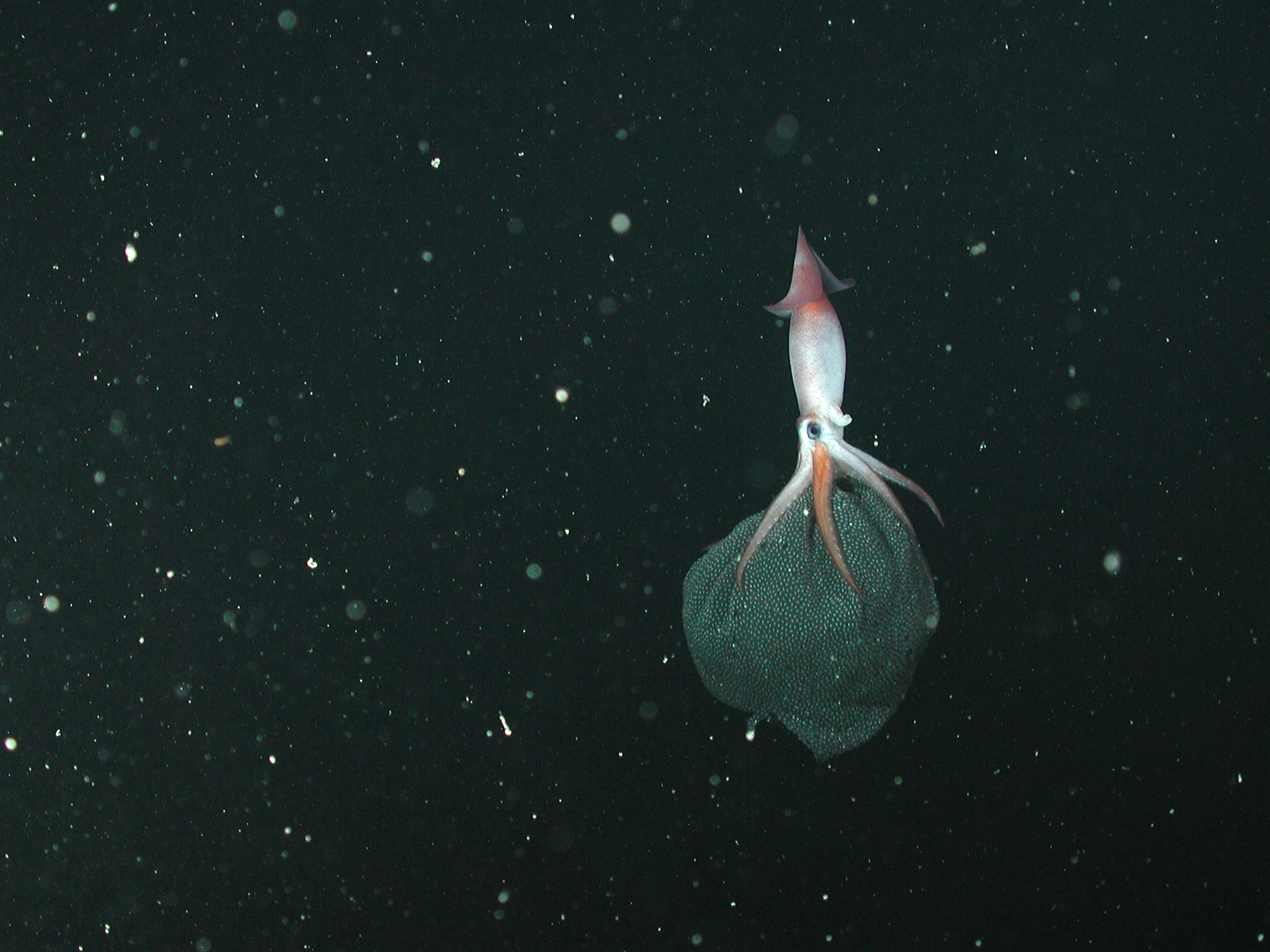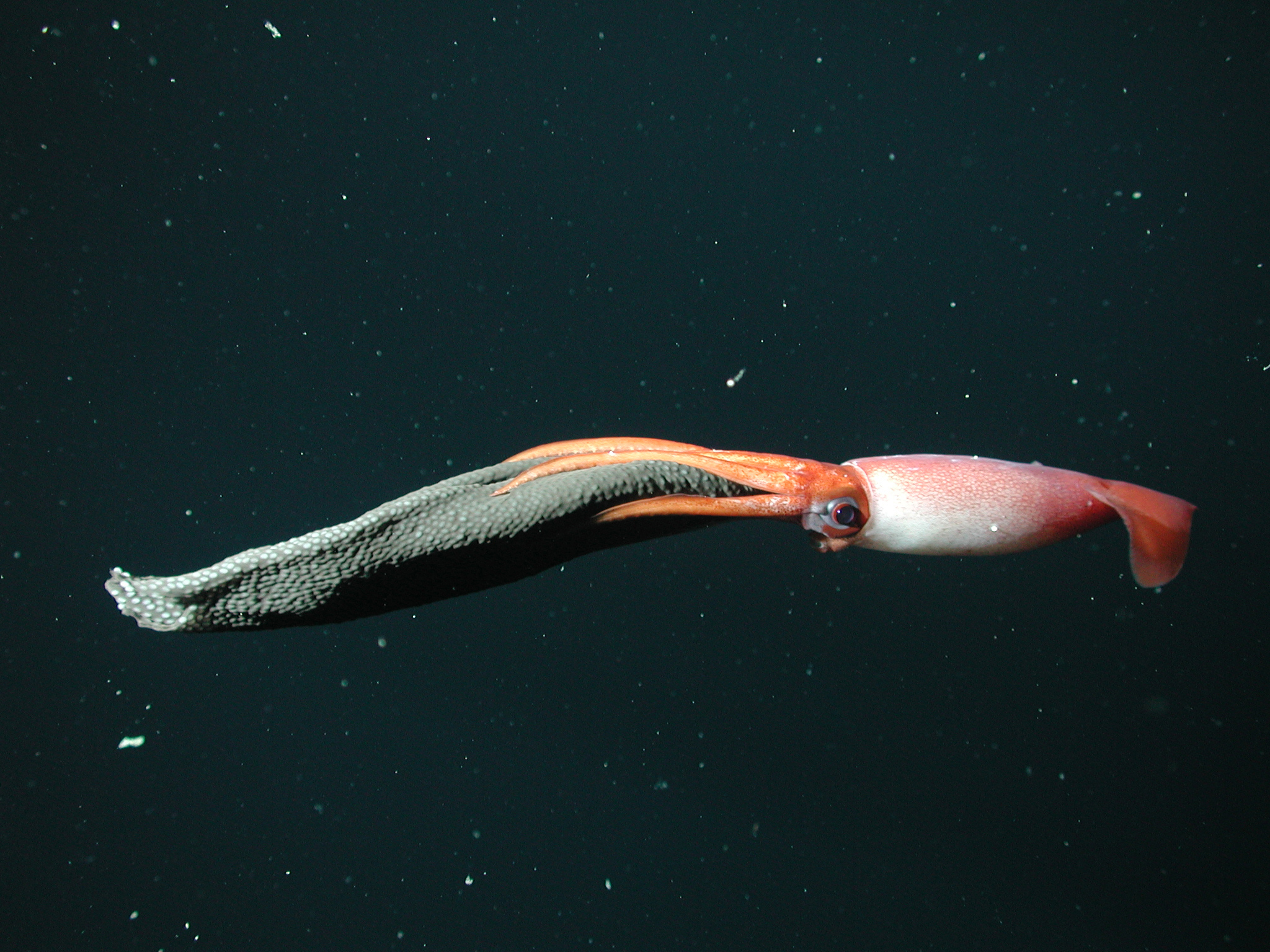The Rare Sight Of A Brooding Squid
This cephalopod will carry and brood its eggs for several months, without feeding.

MBARI’s remotely operated vehicle Tiburon captured this photograph of a female Gonatus onyx carrying a large egg mass, which is suspended from hooks on the squid’s arms. In this photograph, the squid is apparently using its arms to pump fresh seawater through the egg mass to aerate it. (c) 2002 MBARI
When Brad Seibel first observed a Gonatus onyx squid brooding an egg sack in 2001, as seen above, “I just remember jumping out of my seat,” he says.
Seibel, who was then a postdoctoral fellow at the Monterey Bay Aquarium Research Institute (MBARI), had gone with his colleagues to explore an underwater canyon off the coast of Monterey, California, with a remotely operated submersible. It was his first research cruise with MBARI, and Seibel had told everyone he wanted to keep an eye out for a G. onyx, and specifically one that was brooding its eggs. They laughed Seibel off—no one had ever seen anything like that before.
But a couple curious events suggested to Seibel that such a spectacle was possible. Years earlier, he had caught a G. onyx in his trawl net during a research trip off the coast of Southern California. He also noticed bits and pieces of an egg mass. “They were unlike any other egg masses I had seen at that point,” he says, but “I had no reason to think they were connected to the squid; they were just floating separately in the trawl [container].”
Then, about a year and a half later, he “caught another specimen that looked more or less like that first one, and in that same trawl net were about 2,000 hatchling squid,” says Seibel. After more research, he suspected that this species could be brooding its eggs—a very unusual behavior for squids, which generally die soon after laying their eggs. He published his theory in Marine Biology in 2000.
Witnessing a G. onyx brooding in the wild a year later bolstered his claim. He remembers that MBARI’s submersible had just reached about 8,200 feet (2,500 meters) when he caught sight of the “serene and graceful” creature holding the sack in its arms.

A female Gonatus onyx squid swims slowly through the water, carrying its sack of eggs. Because brooding squid cannot swim very quickly, they may be easy prey for deep-diving marine mammals. (c) 2002 MBARI
“We knew that they were neutrally buoyant, meaning they don’t require any effort to float or swim; they can just lay there,” he says. “But I was just struck by how motionless she was. The fins were barely moving, but the entire egg mass and the animal were horizontal, just hovering completely motionless in mid-water.”
Siebel, who is now a professor of biological oceanography at the University of South Florida, eventually observed five or six other individual brooding G. onyx squid during his time at MBARI. He published his findings in Nature in 2005. At the time, G. onyx became the first confirmed squid species known to take care of its offspring after spawning (MBARI has since observed another squid species brooding its eggs).
Based on his observations and measurements of the sizes of the squid eggs (about 4-5 millimeters) and the seawater temperatures (about 2 degrees Celsius) at which they were developing, Seibel speculates that G. onyx mothers hold on to their egg sacks (containing about 3,000 eggs) for about nine months. After this period, the mothers are quite sluggish and weak—the egg mass they’re toting blocks their mouth. The squids Seibel observed also had nubs where two feeding tentacles should have been, suggesting that mothers might bite the appendages off before spawning so they don’t obstruct the egg mass. Seibel suspects the mothers probably die soon after the eggs hatch.
There is still no direct evidence revealing how or when the eggs hatch naturally; MBARI researchers have only witnessed eggs hatching when they disturbed a mother with light and turbulence from their submersible. Seibel surmises that, “once they reach some point of development, the mother is able to trigger this hatching in response to a potential predator or some other problem, or just whenever they are ready.”
Seibel has since witnessed another maternal marvel in the cephalopod world: an octopus that protected its eggs for four-and-a-half years—the longest-known brooding period for any animal. “It puts parenthood in perspective, for sure,” he laughs.
With every donation of $8 (for every day of Cephalopod Week), you can sponsor a different illustrated cephalopod. The cephalopod badge along with your first name and city will be a part of our Sea of Supporters!
Chau Tu is an associate editor at Slate Plus. She was formerly Science Friday’s story producer/reporter.